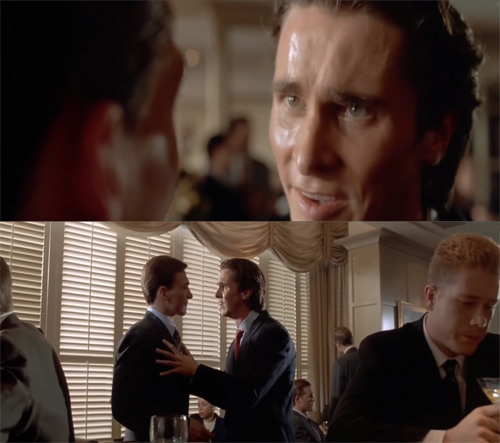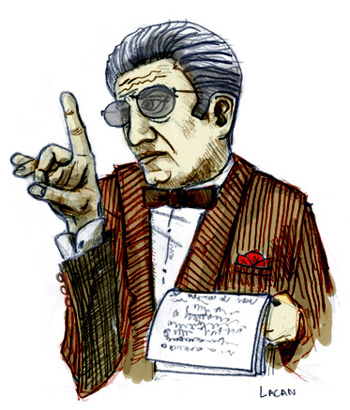
Your complimentary articles
You’ve read one of your four complimentary articles for this month.
You can read four articles free per month. To have complete access to the thousands of philosophy articles on this site, please
Films
American Psycho
Matthew Gildersleeve goes to the movies with Jacques Lacan.
Jacques Lacan (1901-1981) was a French psychoanalytical philosopher. I would like to apply some of his ideas to Mary Harron’s film American Psycho (2000) in order to understand the psychotic behaviour of its protagonist, ‘Patrick Bateman’. My hope is that explaining the film in these terms will contribute to a better understanding of psychosis. Specifically, I want to show that we can understand ‘Bateman’s’ psychotic behaviour in Lacanian terms, since his behaviour at the end of this movie demonstrates the lived experience of psychosis, where, as Lacan says, “That which has not seen the light of day in the symbolic appears in the real.”
All will be revealed.
Lacan & Psychosis
To understand Lacan’s interpretation of psychosis, it is imperative to first grasp his concept of ‘foreclosure’. In Lacan, Language, and Philosophy (2009), Russell Grigg explains that foreclosure is an “initial, primary expulsion” of an idea or symbol whose expulsion “constitutes a domain that is external to, in the sense of radically alien or foreign to, the subject and the subject’s world. Lacan calls this domain the ‘real’.” Thus the ‘real’ in Lacan’s sense is not simply what we mean by the everyday use of the term. Rather, it refers to a world that is psychologically separated from a person’s own inner world; and foreclosure is the process of psychological separation. These concepts are also fundamental to understanding ‘Bateman’s’ behaviour in American Psycho. I put ‘Patrick Bateman’ in inverted commas because, as will be explained, ‘Patrick Bateman’ is not real-ly Patrick Bateman.
It is also important to grasp the real in contrast to the Lacanian category of the symbolic, which is that aspect of human experience that involves the production and understanding of the meaning of an experience. When an experience is not meaningfully understood in the symbolic category, it is rejected and “subsists outside of symbolization – that is, as what is ‘foreclosed’” in the real. But although the real can be excluded from the symbolic field, it may nevertheless appear in ‘the real’. It will do so, for instance, in the form of hallucinations or delusions. As Grigg explains, the “real is capable of intruding into the subject’s experience in a way that finds him or her devoid of any means of protection” (ibid). Hence, as Lacan says, “That which has not seen the light of day in the symbolic appears in the real.” This is exactly what we find in American Psycho.
In even deeper Lacanian terms, the movie demonstrates that the main character in American Psycho creates the imaginary reality of ‘Patrick Bateman’ through foreclosure of a ‘primordial signifier’ (symbol) – ‘the Name-of-the-Father’, which we might think of as the idea of paternal authority. Lacanian scholars commonly agree that the foreclosure of this primordial signifier is the cause of psychosis. This is because this signifier allows a person to overcome the Oedipus complex, since “Its function in the Oedipus complex is to be the vehicle of the law that regulates desire – both the subject’s desire and the omnipotent desire of the maternal figure.” In other words, the Oedipus complex is overcome through the ‘paternal metaphor’ of the Name-of-the-Father. This “is an operation in which the Name-of-the-Father is substituted for the mother’s desire, thereby producing a new species of meaning.” Without this new meaning concerning the desire of the mother provided by the signifier of the Name-of-the-Father, “the subject is left prey to… the mother’s unregulated desire, confronted by an obscure enigma… that the subject lacks the means to comprehend” (ibid). The foreclosure of this primordial signifier is therefore catastrophic for the person undergoing it, resulting in psychosis.

That awful moment when your lawyer tells you you aren’t a serial killer.
© Lions Gate Films 2000
The Real In American Psycho
In his article ‘Diagnosing an American Psycho’ (International Review of Psychiatry, 21, 3), Wayne Parry provides a summary of the plot of the movie. The narrative centres around ‘Patrick Bateman’s’ murder of his colleague Paul Allen. As Parry says, “Bateman chooses to kill Allen out of envy. They meet for dinner and afterwards, in Bateman’s apartment, Allen is very drunk and Bateman attacks him with an axe and disposes of the body. He changes Allen’s answerphone message to say that he [Allen] has gone to London and packs a bag to corroborate the supposed trip.” After this, “Bateman continues his murderous spree, often using Allen’s apartment as the site of the murder or a place to keep the bodies.” Yet ‘Bateman’s’ serial killing suddenly unravels towards the end of the film. “When Bateman is caught by a police car having killed an elderly lady, he kills the policemen and blows up the patrol car. Having killed a night porter and a janitor. he phones his lawyer, confessing all his crimes and the events of that night.”
However, after his confession of his serial killing to his lawyer, we start to see ‘the real’ intruding on ‘Bateman’s’ psychotic symbolic universe: “The following morning, Bateman goes to Allen’s apartment only to find that it is empty and undecorated. As he checks a closet where he left a few bodies, an estate agent asks him to leave after Bateman questions what had happened there.”
This is in fact the first of three crucial moments in this film where we recognise the true nature of the psychosis of ‘Patrick Bateman’. Here the truth that Bateman has been foreclosing cannot be kept excluded: in the earlier parts of the film, ‘Bateman’ had used “Allen’s apartment as the site of the murder or a place to keep the bodies” (‘Diagnosing…’, p.281), but now the apartment is empty. This gives the viewer a clue that ‘Bateman’s’ symbolic universe is not what it appears to be. As Slavoj Žižek puts it, this moment is when “the barrier separating the real from reality… is torn down, when the real overflows reality” (Looking Awry: An Introduction To Jacques Lacan Through Popular Culture, 1992, p.20).
There are also two other moments in the film when the real overflows into ‘Bateman’s’ symbolic world. The second of these is even more significant than the first. “Bateman runs into his lawyer in a bar and asks if he got the phone message last night. The lawyer believes that the call was a joke. Bateman tries to convince him that it is true but the lawyer states that he had dinner twice with Paul Allen in London ten days prior, leaving the reality of the events ambiguous” (‘Diagnosing an American Psycho’).
It is important to note something else from this scene that was missed by Parry but picked up by André Loiselle in ‘Canadian Horror, American Bodies’, (Brno Studies in English, 39 (2), 2013). Loiselle quotes the transcript from the film:
Patrick: Don’t you know who I am? I’m not Davis. I’m Patrick Bateman. We talk on the phone all the time. Don’t you recognize me? You’re my lawyer. Now, Carnes, listen. Listen very, very carefully. I killed Paul Allen, and I liked it. I can’t make myself any clearer.
Lawyer: But that’s simply not possible. And I don’t find this funny anymore.
Patrick: It never was supposed to be. Why isn’t it possible?
Lawyer : It’s just not.
Patrick: Why not, you stupid bastard?
Lawyer : Because I had dinner with Paul Allen… twice in London, just ten days ago.

Jacques Lacan © Ironie 2007
This is a crucial moment to retrospectively understand everything in the film up until then. This scene highlights the expulsion and foreclosure of the real in ‘Bateman’s’ psychotic symbolism, since it turns out that not only did ‘Bateman’ not kill Paul Allen, but ‘Bateman’s’ real name is Davis!
Unfortunately, what the lawyer, Carnes, is saying to ‘Bateman’ is “radically alien or foreign to the subject and the subject’s world.” It’s alien to Davis (‘Bateman’) because, as Lacan might put it, “the desire of the Other” has been foreclosed from Davis’s psychotic symbolic reality (in this instance, ‘the Other’ is the lawyer, who called him Davis and who told him that Paul Allen is not dead; and so the desire of the Other is what the lawyer believes). Yet although Davis may have excluded a fact from his symbolic universe “it may nevertheless appear in reality.” Thus Lacan’s remark, “That which has not seen the light of day in the symbolic appears in the real.” This is exactly what we find in this scene in American Psycho, when the real intrudes on Davis’s psychosis.
The conclusion that Davis lacks the means to comprehend the desire of the Other – what the lawyer is saying – is supported by the final scene of the movie, where after hearing this revelation from Carnes, Davis returns to his friends’ table in confusion. His friends are watching Ronald Reagan give a speech on television, and arguing about whether or not Reagan is lying. One of his friends asks, “Bateman? Come on, what do you think?” This small detail demonstrates that Davis lacks the means to “comprehend the desire of the Other”: with this detail, the viewer can understand that we are now watching events through ‘Bateman’s’ psychotic symbolic universe again. So the Lacanian interpretation of this scene is that Davis lacks the means to comprehend the desire of the Other which appeared in the real as an intrusion to the psychotic symbolic universe in which Davis imagined he was a serial killer called ‘Patrick Bateman’.
The other moment in which the viewer sees the way things really are instead of through Davis’s fantasy, is when his secretary is shown to be “leafing through his [Davis’s] diary alone in his office, where she discovers an escalating number of poisonous doodles and designs devoted to the desecration of women’s bodies, much like the various murders he claims to have committed” (from ‘Canadian Horror…’ p.130). With this and the other two moments we have examined, the viewer can see that, as Loiselle says, “This scene clearly establishes the overriding possibility that ‘Bateman’s’ violence has all along been confined to the level of daydream and fantasy.” The viewer can also now recognise that the majority of the film has been shown through this psychotic fantasy.
© Matthew Gildersleeve 2016
Matthew Gildersleeve teaches and researches at the University of Queensland in Brisbane.









